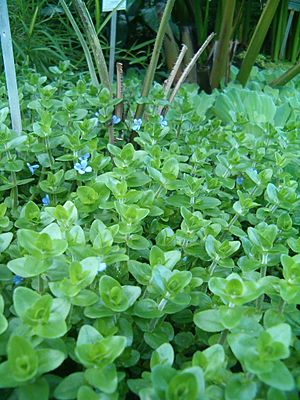Bacopa caroliniana facts for kids
Quick facts for kids Bacopa caroliniana |
|
|---|---|
 |
|
| Scientific classification | |
| Genus: |
Bacopa
|
| Species: |
caroliniana
|
Bacopa caroliniana is a cool flowering plant that often grows in wet, marshy places. It's also known by a few other names, like Giant Red Bacopa or Lemon Bacopa, because of its unique features. People often grow it in aquariums because it loves water!
Contents
What is Bacopa Caroliniana?
This plant is a perennial herb, which means it lives for more than two years. It's a creeping plant, so it tends to spread out along the ground or water.
Other Names for the Plant
You might hear Bacopa caroliniana called by these names:
- Giant red bacopa
- Lemon bacopa
- Water hyssop
Where Does it Grow?
You can find Bacopa caroliniana naturally in wet, marshy areas. It's common in the southern United States and also in South Korea.
What Does it Look Like?
Bacopa caroliniana has thick, juicy leaves that feel a bit like rubber. If you gently crush a leaf, it smells like lemons! The leaves are shaped like a spoon and grow in pairs opposite each other on the stem.
Flowers and Size
The flowers of this plant are a pretty blue color and have five petals. The plant can grow quite tall, reaching about 50 to 100 centimeters (around 20 to 40 inches) in height.
Growing Above and Below Water
This plant is super adaptable! It can grow both underwater and above the water. When it grows above water, its leaves become a bit waxy. It can even flower underwater sometimes, but those flowers don't last long. For the plant to make seeds, it needs cross-pollination, which means pollen from one plant has to reach another.
Growing Bacopa Caroliniana
Because it grows so well in water, Bacopa caroliniana is a really popular plant for aquariums. It's quite easy to grow and can even handle water that's a little bit salty.
How to Grow New Plants
You can easily grow new Bacopa caroliniana plants from cuttings. This means you just snip off a piece of the plant and plant it, and it will grow roots and become a new plant.
Light and Color
The color of the leaves can change depending on how much light the plant gets. If it has lots of light, the leaves might turn a bronze color or even a deep red!
Growing in Different Places
In the wild, it grows in wet, boggy places or partly submerged in water. It can handle being completely flooded. If you live in a warm area, you can grow it in or near a pond. It can also be grown in shallow dishes or as a houseplant, as long as it stays damp. It grows all year round but doesn't like frost. If it gets damaged by frost, it can often grow back from its roots. It also likes a bit of shade.
Aquarium Care
In an aquarium, Bacopa caroliniana needs good lighting to grow strong and healthy. However, it can still survive even if the light isn't super bright. It prefers a clean environment with plenty of nutrients.
Glowing Plants! (Bioluminescence)
Scientists have done some amazing things with Bacopa caroliniana! They found that if they put tiny gold particles, called nanoparticles, into the plants, the chlorophyll (the green stuff in plants that helps them make food) started to produce a reddish light. This means the plants actually glowed!
Plants That Help the Planet
While these plants were glowing, they actually took in more carbon from the air than normal. This is because the glowing made their cells do more photosynthesis, which is how plants make their own food using sunlight and carbon dioxide.
A research team from Taiwan hopes to use these special glowing Bacopa caroliniana plants as eco-friendly street lamps. Imagine streets lit up by glowing plants! This idea is called a "triple threat" because it could save energy, help reduce global warming by taking in more carbon, and keep streets safely lit at night.

